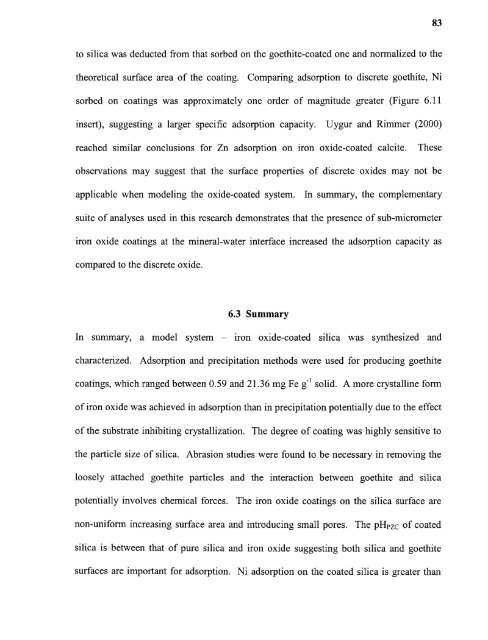Heavy metal adsorption on iron oxide and iron oxide-coated silica ...
Heavy metal adsorption on iron oxide and iron oxide-coated silica ...
Heavy metal adsorption on iron oxide and iron oxide-coated silica ...
You also want an ePaper? Increase the reach of your titles
YUMPU automatically turns print PDFs into web optimized ePapers that Google loves.
83to <strong>silica</strong> was deducted from that sorbed <strong>on</strong> the goethite-<strong>coated</strong> <strong>on</strong>e <strong>and</strong> normalized to thetheoretical surface area of the coating. Comparing <str<strong>on</strong>g>adsorpti<strong>on</strong></str<strong>on</strong>g> to discrete goethite, Nisorbed <strong>on</strong> coatings was approximately <strong>on</strong>e order of magnitude greater (Figure 6.11insert), suggesting a larger specific <str<strong>on</strong>g>adsorpti<strong>on</strong></str<strong>on</strong>g> capacity. Uygur <strong>and</strong> Rimmer (2000)reached similar c<strong>on</strong>clusi<strong>on</strong>s for Zn <str<strong>on</strong>g>adsorpti<strong>on</strong></str<strong>on</strong>g> <strong>on</strong> ir<strong>on</strong> <strong>oxide</strong>-<strong>coated</strong> calcite. Theseobservati<strong>on</strong>s may suggest that the surface properties of discrete <strong>oxide</strong>s may not beapplicable when modeling the <strong>oxide</strong>-<strong>coated</strong> system. In summary, the complementarysuite of analyses used in this research dem<strong>on</strong>strates that the presence of sub-micrometerir<strong>on</strong> <strong>oxide</strong> coatings at the mineral-water interface increased the <str<strong>on</strong>g>adsorpti<strong>on</strong></str<strong>on</strong>g> capacity ascompared to the discrete <strong>oxide</strong>.6.3 SummaryIn summary, a model system — ir<strong>on</strong> <strong>oxide</strong>-<strong>coated</strong> <strong>silica</strong> was synthesized <strong>and</strong>characterized. Adsorpti<strong>on</strong> <strong>and</strong> precipitati<strong>on</strong> methods were used for producing goethitecoatings, which ranged between 0.59 <strong>and</strong> 21.36 mg Fe g -1 solid. A more crystalline formof ir<strong>on</strong> <strong>oxide</strong> was achieved in <str<strong>on</strong>g>adsorpti<strong>on</strong></str<strong>on</strong>g> than in precipitati<strong>on</strong> potentially due to the effectof the substrate inhibiting crystallizati<strong>on</strong>. The degree of coating was highly sensitive tothe particle size of <strong>silica</strong>. Abrasi<strong>on</strong> studies were found to be necessary in removing theloosely attached goethite particles <strong>and</strong> the interacti<strong>on</strong> between goethite <strong>and</strong> <strong>silica</strong>potentially involves chemical forces. The ir<strong>on</strong> <strong>oxide</strong> coatings <strong>on</strong> the <strong>silica</strong> surface aren<strong>on</strong>-uniform increasing surface area <strong>and</strong> introducing small pores. The pHpzc of <strong>coated</strong><strong>silica</strong> is between that of pure <strong>silica</strong> <strong>and</strong> ir<strong>on</strong> <strong>oxide</strong> suggesting both <strong>silica</strong> <strong>and</strong> goethitesurfaces are important for <str<strong>on</strong>g>adsorpti<strong>on</strong></str<strong>on</strong>g>. Ni <str<strong>on</strong>g>adsorpti<strong>on</strong></str<strong>on</strong>g> <strong>on</strong> the <strong>coated</strong> <strong>silica</strong> is greater than
















